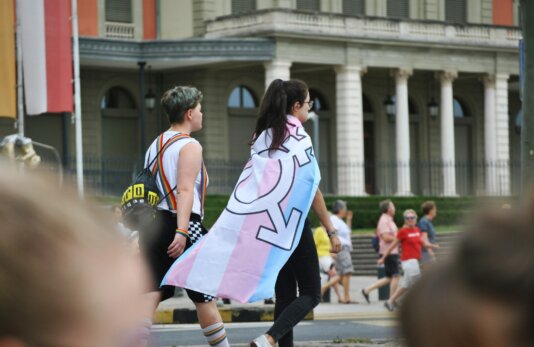- About
- Topics
- Picks
- Audio
- Story
- In-Depth
- Opinion
- News
- Donate
- Signup for our newsletterOur Editors' Best Picks.Send
Read, Debate: Engage.
| topic: | Human Rights |
|---|---|
| tags: | #Trump 2.0, #gender equality, #HIV/AIDS |
| located: | Peru, Uganda, Brazil, USA, Hungary, Malawi |
| by: | Sarah Hawkes, Kent Buse |
Figures around the biggest killer diseases highlight growing challenges around the world.
Getting people diagnosed and treated is crucial, and this requires that decision-makers have the right information. But accessing data on gender and health has just become a lot more difficult.
In his first day in office, US president Donald Trump issued an executive order banning the term "gender" in all federal policies and documents. The order stated that the US would recognise only two sexes - female and male.
Last week [4 April], Global Health 50/50 published data that showed how people in 204 countries are diagnosed and treated for hypertension, diabetes and HIV. By collecting data disaggregated by sex, age, country and condition, our team discovered significant disparities in exposure to risk, and rates of diagnosis, treatment and outcomes for these conditions.
For example, in Peru, men aged between 30 and 44 are three times more likely to die from hypertension than women. In Uganda, a quarter of men and 40 per cent of women in this age group are overweight, and more than twice the number of men compared to women die from a diabetes-related condition.
Sex (biology) alone cannot explain the differences: gender plays a major role in understanding why people smoke or drink alcohol, or what stops a person from visiting their doctor or dropping out of treatment. Only by addressing gender can health policies, interventions and programmes be tailored and targeted to improve health and livelihoods for all.
Our hope of expanding this kind of analysis to more conditions in more countries using the Gendered Health Pathways tool has been dealt a severe blow.
The impact of Trump’s executive order was immediate and far-reaching. The US is the largest funder of global health and wields huge influence.
Within a month, health datasets and websites that used language forbidden by the administration had been removed. The Demographic and Health Survey Initiative, which sat in the US aid agency, USAID, and collected data on topics ranging from reproductive health to nutrition, has been paused.
In a snapshot survey conducted by Global Health 50/50 last month, about a fifth of the 72 US-headquartered health organisations in their sample had already removed language relating to gender equality from their websites, including the National Institutes of Health. Pages on the Centers for Disease Control and Prevention website, meanwhile, are displaying banners expressing the US administration’s rejection of language.
These are worrying developments and will cost lives.
Gender is a contentious term and has been defined in different ways depending on who is controlling the narrative. For years it has been used to exert control over reproductive bodies, supported by a growing army of anti-gender ideology advocates. Aside from Trump, in 2019, Brazilian president Jair Bolsonaro announced an end to gender ideology. A year later, Hungary passed a law which prescribed sex at birth as the only legally recognised category, ending recognition of trans people.
We cannot achieve health equity - a requirement of the UN sustainable development goals - unless we view and everyone’s health through a gender lens.
There is currently no consensus on the definition of gender in the global health sector and it has often been conflated with sex - biological characteristics of females and males - or misunderstood to mean women and girls. This needs to change. The Lancet Commission on Gender and Global Health, which on Monday [7 April] published its five-year research into gender justice in health, is calling for clarity and transparency in how terminology is used and to adopt systems for data collection and analysis that give us a better understanding of health needs.
It also calls for stronger accountability mechanisms to monitor and guide action against anti-gender ideologues, as well as commercial actors that profit from harmful products by exploiting gender norms.
This can transform lives.
In Malawi, for example, researchers discovered that fewer men tested for HIV than women because they were often not offered a test when they visited health centres. They tended to drop out of antiretroviral treatment because of financial concerns and often experienced difficulties getting back on to a regime. It wasn’t because they didn’t want help.
This research led to new thinking around engaging men in health services, including the creation of Men’s Spaces in communities and in health centres, and considering how men can be better supported to stay on ARVs. Researchers also found that men regularly brought their sick children to health centres, confounding the stereotype around men’s care role.
Achieving gender justice in health is not a zero-sum game. Not only can it improve individual lives and livelihoods, it will ultimately improve societies. We have taken important steps forward. We can’t afford to lose what we have achieved so far.
Sarah Hawkes is the Head of Global Population Health at Monash University Malaysia and Co-Founder and Co-CEO of Global Health 50/50.
Kent Buse is a professor of Health Policy and the Director of Programme Development at Monash University Malaysia and Co-Founder and Co-CEO of Global Health 50/50.
Image by Delia Giandeini.
